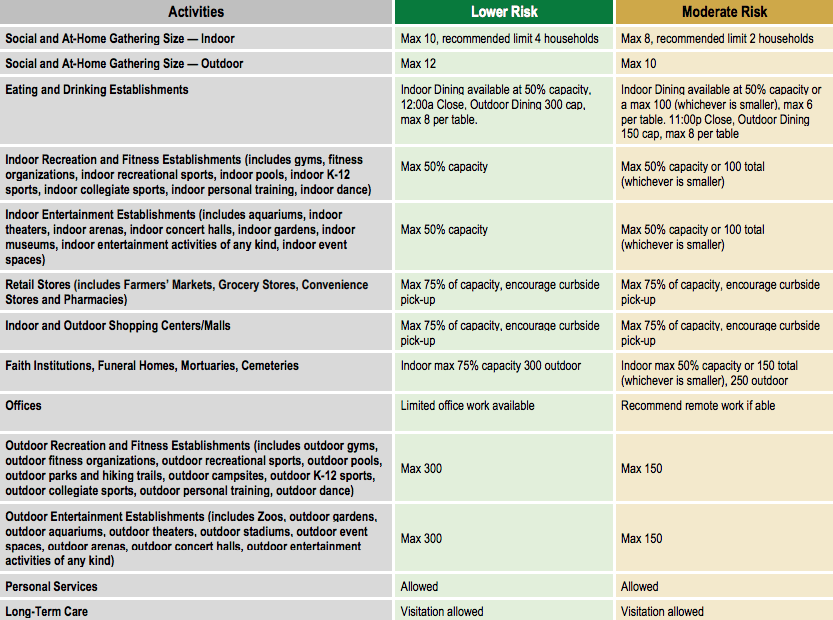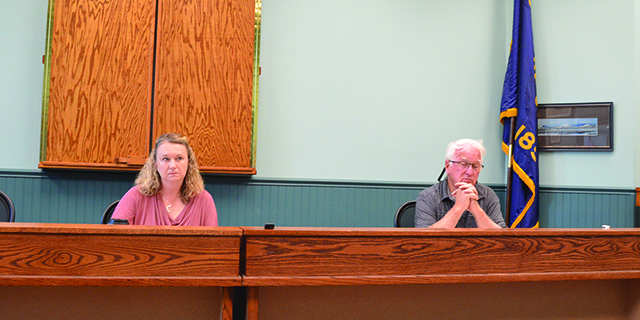Statewide risk assessment plan begins this week
Published 6:00 am Wednesday, December 2, 2020

- This screenshot shows the two lowest tiers of Gov. Kate Brown’s new four-tier risk assessment plan, which goes into effect Thursday, Dec. 3, 2020. Wallowa County will begin in the lowest tier of the four.
ENTERPRISE — The “two-week freeze” is over at the end of the day today, Wednesday, Dec. 2.
In its place, beginning on Thursday, will be a new four-tiered risk-assessment plan, announced last week by Gov. Kate Brown. Each county is placed in one of four categories which will loosen or tighten what counties are permitted to do.
Wallowa County, which as of Tuesday, Dec. 1, had 71 cases — but has leveled off after doubling in about a month during October and November — was placed in the low-risk category, meaning there are fewer restrictions in place for it and the three other counties classified as low-risk.
“There’s four or five that got put in that green area that allowed us a little more autonomy,” Wallowa County Commissioner Todd Nash said. “We’re just at that low-risk number. We’ve either been lucky, or we’ve done well for keeping the numbers low here.”
Nash said the move made by the state is an improvement, but he still would like to see the government less involved and the counties have even more autonomy.
“It’s better than it was. I don’t think, as elected officials, it’s in our purview to tell how many people can gather in one spot,” he said. “People have had enough time to evaluate the virus and what to do to protect themselves and the most vulnerable.”
Sizes on social gatherings are still severely restricted — to a max of 10 for indoor gatherings and 12 outdoors — though the number decreases at each stage — to a limit of six indoors and outdoors for the 25 extreme-risk counties.
Indoor dining is again permitted at restaurants in the low-risk category, now at 50% capacity, with establishments having the OK to stay open until midnight. An additional limit is eight people at each table.
Recreation and fitness establishments, and indoor entertainment establishments, are allowed to open at a maximum capacity of 50% — and outdoor venues are capped at 300 — while retail stores and shopping centers can have a maximum capacity of 75%.
Churches, funeral homes, cemeteries and mortuaries also can be open at 75% capacity. Offices can be open to “limited” work.
Long-term care facilities can also open their doors to visitors in low-risk areas.
Commissioner John Hillock said he was OK with the number of people allowed, but was concerned about if smaller counties, like Wallowa, could be more greatly impacted in having to move to a different risk range if it had a small uptick in cases. He admitted, though, that he had not yet analyzed the numbers.
“It’s all subjective to somebody doing a spreadsheet on this and seeing if it works,” he said.
Commissioner Susan Roberts said the plan to move to the tiered risk assessment post-freeze already was in place before the letter elected officials sent to Brown asking for autonomy was submitted.
“What they told us was they wanted to shut everything down so people could even out, and then when they came out with the new message it wouldn’t be confusing,” she said. “Things couldn’t be more confusing.”
Roberts expressed mixed emotions about the tiered-risk plan. While she said she appreciated that it appeared smaller communities were taken into consideration more, she added she doesn’t believe the oversight by the government is necessary.
“We’re taking it serious. Nobody is ignoring it,” she said. “Everyone is taking precautions for themselves, their families, and that should be sufficient.”
Roberts also is concerned that some citizens are being emboldened and encouraged to report businesses or individuals — perhaps unnecessarily.
“The thing that bothered me the most out of all of this is some folks have decided they have become the watchdogs or the appointed watcher of all the rest of us,” she said. “That is disturbing to me.”






